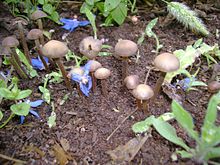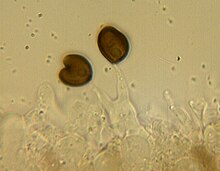| Panaeolus bisporus | |
|---|---|

| |
| Scientific classification | |
| Domain: | Eukaryota |
| Kingdom: | Fungi |
| Division: | Basidiomycota |
| Class: | Agaricomycetes |
| Order: | Agaricales |
| Family: | Bolbitiaceae |
| Genus: | Panaeolus |
| Species: | P. bisporus
|
| Binomial name | |
| Panaeolus bisporus (Malencon and Bertault) Singer and Weeks
| |
| Synonyms | |
|
Panaeolus bispora | |
| Panaeolus bisporus | |
|---|---|
| Gills on hymenium | |
| Cap is convex | |
| Hymenium is adnexed | |
| Stipe is bare | |
| Spore print is black | |
| Ecology is saprotrophic | |
| Edibility is psychoactive | |
Panaeolus bisporus, also known as Copelandia bisporus is a rare and widely distributed little brown mushroom that bruises blue and contains the hallucinogen psilocybin.
This mushroom is similar macroscopically to Panaeolus tropicalis, Panaeolus cambodginiensis and Panaeolus cyanescens, but can be differentiated using a microscope by its two spored basidia.
Description[edit]

This is a little brown mushroom that grows on dung and has black spores. It has been found in Hawaii, Southern California, North Africa, Spain and Switzerland.
Cap: 15-30 mm tan to gray fading to black sometimes when covered with spores and with a defined ring zone somewhat globe shaped or bell shaped to convex, hardly expanding, margin often torn and pedaled, smooth not viscid, and slightly wrinkled and pitted with age. Dark grey-brown drying whitish.
Gills: adnexed or narrowly attachedtightly packed, mottled gray to jet black, white edges
Stem: white, fibrous, 65-120 mm long 2-3 mm thick, hollow, translucent gray, bruising heavily blue where bruised
Spores: jet black, elliptical, 12-14 x 8-10 x 6-7.5 µm smooth and opaque, elongated with germ pore straight off the end
Habitat: saprotrophic on grasses
Microscopic features: 2 spored basidia 18 - 23 × 8-10 µm, cheilocystidia are bottle shaped and clear 20-30 µm, metuloids with yellow brown walls 40-55 × 12-15 µm some with excreted crystals
See also[edit]
References[edit]
- Stamets, Paul (1996). Psilocybin Mushrooms of the World. Berkeley: Ten Speed Press. ISBN 0-9610798-0-0.